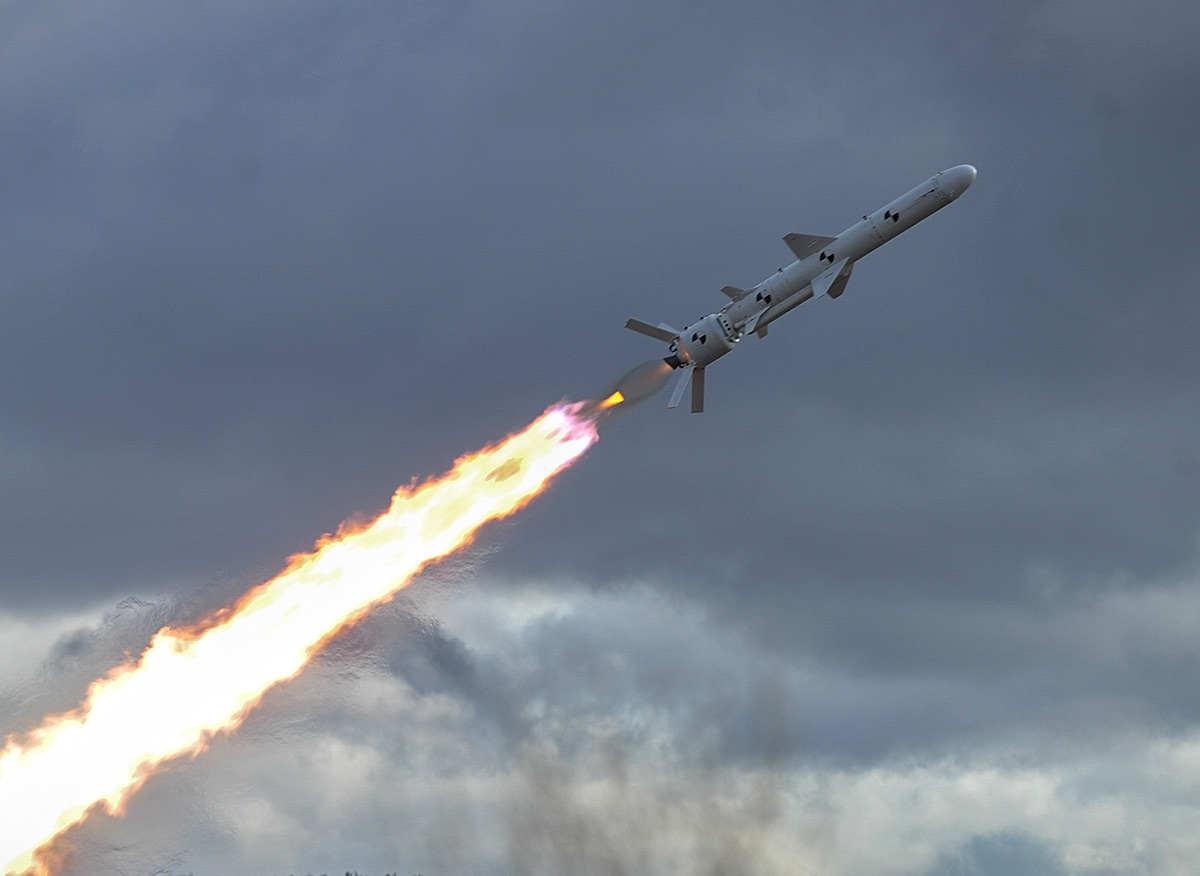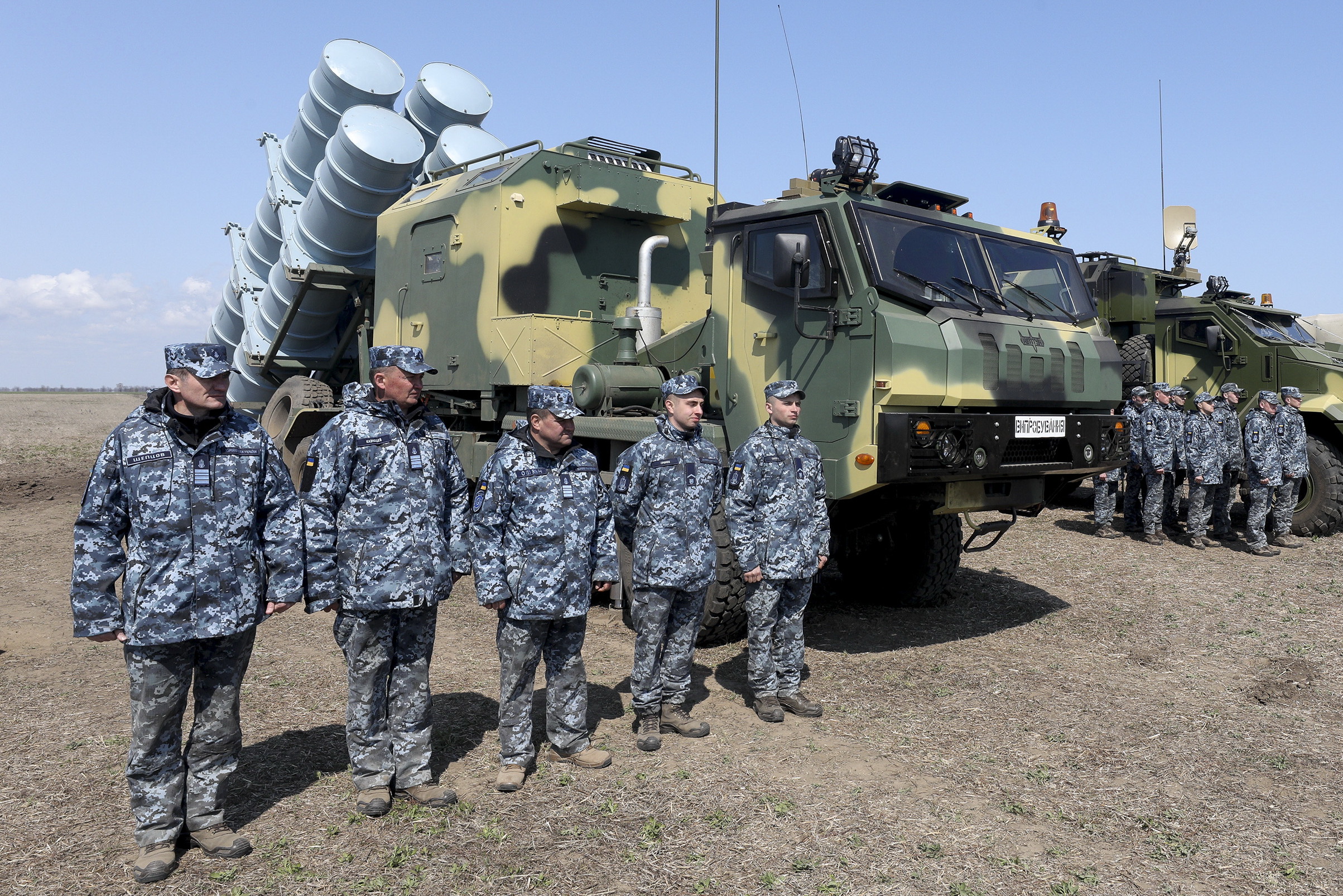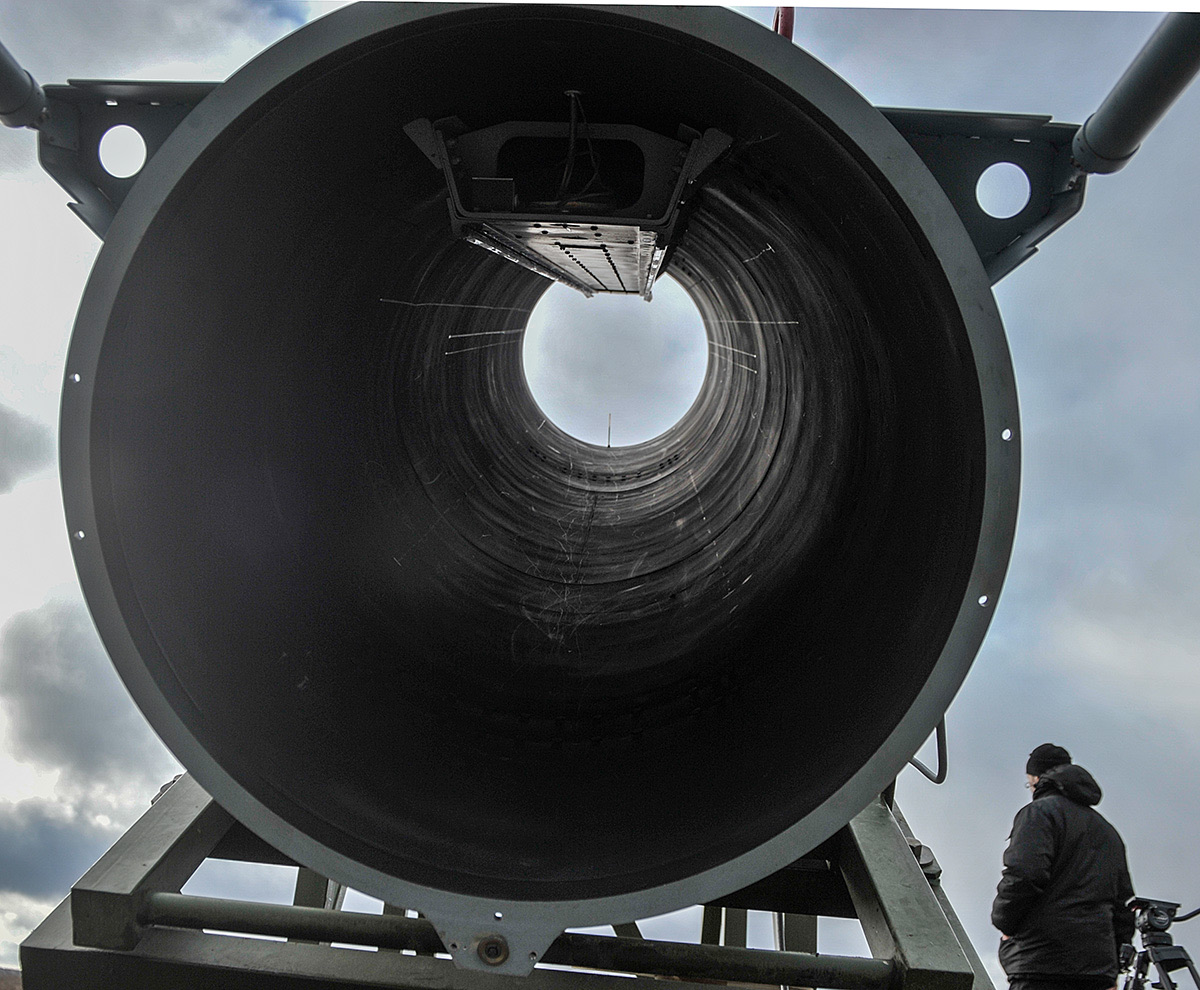Ukraine’s defense industry has done something that few would reasonably expect it to be a success in.
Over the last few years, it has created a brand new cruise missile: Neptune, its first almost purely indigenous anti-ship system that will hopefully stand up to Russia’s threat at sea.
JOIN US ON TELEGRAM
Follow our coverage of the war on the @Kyivpost_official.
Despite the poor shape of the arms industry and lack of experience, Ukrainian engineers in a very short time managed to make a sophisticated, high-precision weapon normally requiring decades of development and tests.
Facing the challenge of improving the nation’s extremely weak coastal defense, the developers have proposed offbeat technological solutions that made the Neptune effective and rather inexpensive.
This new missile is now being prepared for the final tests and entry into service. Experts say that the Neptune’s success in the Armed Forces would mean a milestone leap forward for Ukrainian military engineering struggling with obsoletion, brain drain, and a lack of funding.
However, the question remains open whether this enthusiastic effort will bear fruit in the coming years.
While the missiles are demonstrating impressive records at live-fire tests, the country’s defense sector will soon face the challenge of rapidly producing enough Neptune missiles to make it a truly effective deterrent weapon against the Kremlin’s maritime supremacy in the Black Sea.
Defenseless
Russia’s invasion of Crimea in 2014 was a crippling blow to Ukraine’s maritime missile power.
Together with up to 80 percent of the country’s naval force, all of the Rubezh mobile coastal defense missile systems (NATO reporting name SSC‑3 Styx) were seized by Russian armed forces.
The whole arsenal of obsolete P‑15M Termit (SSN‑2 Styx) shipwreck cruise missiles operated since 1960 was presumably left behind too.
According to experts from the Ukrainian Military Portal, a Kyiv-based defense community, the only Ukrainian vessel capable of carrying such missiles was the 230-ton Pryluky missile boat, deeply obsolete itself. However, the Termit missiles are so old-fashioned that they pose no serious threat, experts believe. Moreover, all missile launching platforms were dismantled from the warship in 2018.
Ukraine was stripped of nearly all of its weapons of this class. And it was therefore left exposed not only to Russia’s amphibious offensive but also to the danger of a maritime blockade.
Grasping at straws, Ukraine’s naval command formed two additional littoral defense units in 2015–2016, the 406th Artillery Brigade in Mykolaiv and the 32nd Missile Artillery Regiment armed with BM‑27 Uragan systems in the Odesa region.
However, that was nothing more than a stopgap. They wouldn’t be effective against warships in actual combat.
Russia’s rapid seizure of the Azov Sea and its aggressive military buildup in the Black Sea soon showed the maritime threat was more than real — and the clock was ticking.
Impromptu design
The basic work on an advanced anti-ship missile project was initiated in 2014 by the Kyiv-based design bureau Luch.
The development was kept top secret until September 2015, when the agency publicly unveiled a Neptune early mockup at the Weapons and Security exhibition in Kyiv.
The missile resembles the Soviet-Russian Kh‑35 cruise missile (NATO reporting name AS‑20 Kayak) developed since the early 1980s and taken into service by the Russian military in 2003.
According to developers, this similarity derives from the dire necessity to be savvy in terms of time and budget. Therefore, they used basic Kh‑35 concepts for the Neptune. In Soviet times, the Kh‑35s were supposed to be produced at the Kharkiv Aviation Plant, and the enterprise’s archives still had blueprints of the Kh‑35 body.
“Not using the available outfitting and manufacturing line in favor of stupidly spending public money to develop a new one would be wrong,” wrote Serhiy Zgurets, the director of the Defense Express consulting company.
“Yes, in the future we’ll switch to composite materials, develop a new body much more compliant with stealth criteria. But now there’s no time to lose, and we need results.”
Next, many of the Neptune’s ingredients were selected and added for the sake of minimizing costs and maximizing the development speed — in many ways, thanks to the engineers’ stratagem.
Convoy reaper
By spring 2016, the first Neptune models were ready for pop-up checks.
The missile progressed quickly: In the following months, time after time, it reached new frontiers at regular live-fire launches.
Having made their maiden flights in late January 2018, the Neptunes successfully engaged their maritime targets at a distance of 100 kilometers in August and at a distance of 280 kilometers in December the same year.
The Luch bureau presents its R‑360 Neptune design as a subsonic anti-ship cruise missile capable of enforcing control of territorial aquatic areas, as well as defending coastal military and civilian infrastructure and repelling a hostile amphibious landing.
The 5.5-meter-long, 700-kilogram ordnance is launched via a solid-fueled booster and propelled further with a propulsion turbojet engine at an average velocity of nearly 970 kilometers per hour. Its maximum range currently reaches 280 kilometers. It carries a 160-kilogram high-explosive fragmentation warhead capable of inflicting critical damage to vessels with up to 5,000 tons of displacement, according to developers.
If that’s the case, the Neptunes are supposedly capable of sinking any of Russia’s Black Sea Fleet vessel except for its flagship, the 11,490-ton missile cruiser Moskva.
As the Ukrainian Military Portal speculates, the missile’s stated specifications allow for effectively targeting vessel types including cruisers, destroyers, frigates, corvettes, and landing craft navigating alone or as part of a convoy.
Other than that, the Neptune, according to designers, features a classified anti-jamming resistance technology increasing the missile’s chances to break through enemy radio-electronic countermeasures and hit the target.
Moreover, the design reportedly envisages advanced navigation units allowing the missile to abruptly dive down to the altitude of just 4–5 meters over the sea surface at the flight’s final stage, which greatly complicates detecting and intercepting Neptune.
Key advancement
For the sake of time and saving on costs, the Neptune developers used in their design old though modified missile starting boosters from long-obsolete Soviet units S‑125 (NATO reporting name SA‑3 Goa), as well as transporter-launcher containers presumably taken from S‑300 (SA‑10 Grumble) air defense systems.
Many other components were produced from scratch, such as the MS‑400 propulsion engine produced specifically for the Neptune by the Motor Sich company based in Zaporizhia.
All experts polled by the Kyiv Post are unanimous about the most crucial component — the new active target-seeking device developed by Kyiv-based Radionix company.
According to Zgurets from Defense Express, the new target seeker has saved dozens, if not hundreds of millions of dollars that would be needed to purchase this technology abroad, which would have been highly unlikely due to the high sensitivity of such a military-purpose design.
“Without this capacity, talking about any possibility of creating new guided ‘surface-to-air,’ ‘air-to-air,’ ‘coast-to-naval surface’ (missiles) in Ukraine would simply not be serious,” as Zhurets noted.
By 2019, the developers had already presented the whole RK‑360MC Neptune mobile coastal defense missile complex carrying four R‑360 missiles. It consists, apart from the missiles, of an acquisition and director radar station, a mobile command post, a transport-load vehicle, and a unified launch platform. Notably, the launch platform is based on a monstrous KraAZ‑7634HE 8×8 chassis provided by the Kremenchuk Automobile Plant.
In May 2019, during yet another live-fire tests, the Neptune accomplished a complicated maneuver over vast expanses of the Black Sea for the first time. It flew 100 kilometers outshore, made a U-turn, and hit the target on the way back. The tests continued in the following months.
By the end of 2019, the Neptune is expected to be approved for service.
New perspectives
The Neptune coastal defense system’s development cost nearly $20 million. According to Luch bureau chief designer Oleh Korostelev, this is the fastest and least expensive missile system development in the world.
Apart from the currently available coastal defense version, the Neptune is expected to expand to having ship-launched and airborne variants in the future.
The potential carrier of the aircraft-launched modification is already determined — it will be the Sukhoy Su‑24M attack aircraft, which is resilient enough to operate such ordnance in combat. This is one of Ukraine’s principal workhorses — the country’s Air Forces have nearly 14 Su‑24Ms in active service.
In terms of naval employment, things appear to be much more complicated.
Initially, the Neptunes were supposed to be mounted on projected 445-ton Lan-class missile boats, then on the Lan’s sister project of 550-ton missile boats Vespa designed by Kyiv-based Kuznya on Rybalsky shipyard.
Some assume Neptune cruise missiles will be carried by the Volodymyr Velykiy corvette painfully being built in Mykolaiv since 2011. Such vessels would carry packs of at least eight missiles. However, none of them is anywhere close to being produced so far, and the deadline for their launches is constantly delayed by years.
Apart from that, in late December 2018, Ukraine’s chief of naval staff Vice Admiral Andriy Tarasov in an interview told the Kyiv Post the Neptune cruise missiles could be mounted on the fleet’s flagship — the 3,100-ton frigate Hetman Sahaidachniy — after 2–3 years of modernization works.
In the meantime, the Neptunes could be placed on the Pryluky boat — but with the capability to carry only two cruise missiles, it is not expected to constitute serious maritime firepower.
It’s not clear whether Ukraine’s defense industry has the capacity to produce enough cruise missiles to resist Russian forces in case of an invasion.
In the opinion of Taras Chmut, the Marine veteran and director of the Ukrainian Military Portal, the nation needs at least 5 Neptune batteries (operating nearly 60 cruise missiles), to deter a Russian amphibious landing.
However, as one of Motor Sich’s top managers, Volodymyr Simeonov, asserted in May, while the state defense order currently envisages procuring 120 cruise missiles, the Luch bureau is capable of issuing only nearly 50 items a year.
Nonetheless, it is the coastal defense systems that are expected to be of top priority in the nearest future. While quantity is an issue, their specifications and firing range of 280–300 kilometers allow for covering much of the Black Sea northern aquatic area, let alone the Azov Sea region, upon the condition of excellent early detection support from the mainland.
Besides, in the wake of the Intermediate-Range Nuclear Forces Treaty’s ultimate collapse on Aug. 2, Ukraine would be fully entitled to enhance the Neptune ranges to 500 kilometers or more. In this regard, the Ukrainian cruise missiles are likely to be open for relatively cheap modifications — through installing even larger reservoirs and consuming more energy-yielding fuel.
You can also highlight the text and press Ctrl + Enter










